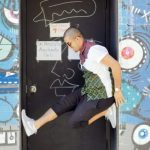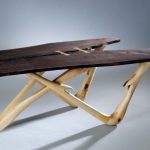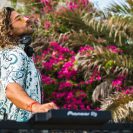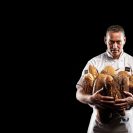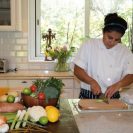There exists a rare breed of human whose talent exceeds not only societal expectations but even that of the self. Jassim Alnashmi is one of these diamonds in a mine. He is not just a talented poet in his own right, but a curator, architect, artist and furniture designer. After graduating from Iowa State University, he came back to Kuwait and exploded into the cultural scene. Here, I get to ask this master of creativity a few questions about his work.
Jassim, you are an as yet unpublished poet and compiled a chapbook at Iowa State University – which has one of the most competitive writing programs globally. Are you planning on publishing it one day?
First of all, I’d like to express how grateful I am to have met you, an inspiring poet. You are as involved as I am and certainly more so in your support for local talent. It is the University of Iowa that has international acclaim for their poetry program and – unfortunately – I only became immersed in poetry during my last year at university; otherwise, I would have done one or two of U of I’s summer workshops. Iowa State also had a high standard for poetry, and I almost joined the Masters program; but I’ve built so much momentum for an architecture career that I didn’t want to impede. So I embarked on writing in my own time, which – with a few more good poems and pointers from a great poet like yourself – I will gladly publish!
You once mentioned that what connects all your work is light and the city. Can you elaborate further?
Light gives life to everything and the city is an ecosystem for human beings. Studying architecture made me more conscious of the infrastructure of cities I visited – as well as the importance of light in shaping human habitats. I became interested in light in all its dimensions, from experimenting with film photography to the design of cities. Louis Kahn is considerably one of the greatest architects of all time and he gave a lecture titled Silence and Light – which was then published. The talk is so straightforward you would think it was a project briefing. At the same time, the content was describing light as the most alive element in nature, one with character and spirituality. He describes the different types of light such as green light and silver light and how one can shape light to shape someone’s mood. His rhetoric is so strong I felt compelled to believe that light is the most important material an architect must work with. At around the same time, I bought my first film camera which is still with me today. Film makes you more aware of light and, with my camera, several mistakes happened because of light leaks. The results in the photographs had a similar atmosphere to that of a beautiful mosque or church or any other great space. So it became clear to me that light is the medium I am to channel all my thoughts through. So, on the one hand light is a speculative and phenomenological criteria for me, on the other hand is a more data-based thought process which is the structure of cities. I would say these two elements are necessarily balancing each other out, like Immanuel Kant’s theory of the Beautiful and the Sublime, or chaos and order. As an architect, I must be aware of issues such as what influences crime in the city or what allows for positive cultural exchange, so that I am able to design correctly. I believe every architect should have a mindset of how to holistically improve society.
People forget that art is not merely an expression of the self, but is for the benefit of social evolution and consciousness. This was exemplified when you participated in Artists for K’S PATH at the Boushahri Gallery. In an age of ‘look-at-me’, how can we encourage artists to give back to the community and support causes dear to us?
Actions speak louder than words. Whether it be through art, education or being involved in private or public enterprises that work to better the community, change happens when people from different walks of life and different roles in the community have the same vision. Artists can ignite change but it needs everyone else to realize it. If it doesn’t happen naturally from the artists, then it must happen with politicians, community organizations or through educating the younger generation.
What’s Your Location? is a show that you curated along with Antonio Da Silva and Ruth Jones. What was its significance? And do you find curating more challenging than participating as an artist?
Curating is very tough, especially with a large number of international artists. As an artist, you are purely invested in your work, but as a curator you must get inside the head of the artist and understand their work as well as they do and the relationship to the concept of the exhibition. As well as all the other artworks, an exhibition with good art can fall apart if it’s not curated well. I wouldn’t say being an artist is easier; it isn’t. I just hadn’t expected curating to be so challenging. What’s Your Location? is an exhibition that discusses the issues of globalization, which is due to excelling improvements in transportation and technology. It is causing an immense cultural exchange which is mainly infamous for diluting culture rather than enriching it. The exhibition is boarding the train of cultural enrichment and exposing this as much as possible. It started in Porto Alegre, Antonio Da Silva’s hometown, then came to Kuwait, where Antonio and I are living. Now, it is set to go to London where Ruth lives. In each location we are including a full cultural program of lectures and workshops 40 to engage in an even deeper dialogue with the community.
Finally, many people struggle to find their calling. However, you have managed to manifest more than one, so you are in a justifiable position to provide us with nuggets of wisdom. Tell us, what drives you and how can you encourage others to take the plunge and allow their passion/s to be manifested?
I have been faced with a very important decision to make – which is to be the jack of all trades or the master of one. I have not made that decision yet. After being in Kuwait and exercising all parts of my brain, it became quite exhausting. I am more keen to believe that it is better to be a master of one; but this is the problem: part of being an architect is to be an octopus, or a chameleon, a man of many faces, which I enjoy. Architecture is the harmonious marriage between science and art, so I feel I am contributing to my role as an architect by producing artwork like photography or poetry, and furniture design is architecture at the scale of a person. These are reasons why I have not settled with only one thing as of yet. Also, my art is a form of research that develops theories for my architecture and design projects. So to find my calling, I’ve set a goal for myself to delve into each field of my interests and see which one or two are still standing after a year or so, which I think everyone should do, how else would you know if you should spend the rest of your life doing this or that?
You can follow Jassim Alnashmi on Instagram @jnashmi and Facebook.com/jassim.nashmi. Or you can find further information regarding his work and upcoming events on his website: jassimalnashmi.com. You can follow Nejoud Al-Yagout on Instagram @nejoud.alyagout and facebook.com/thisisanimprint. Fnd out more about her books and events on her website: www.nejoudalyagout.com. Photo by @vijaynyack


